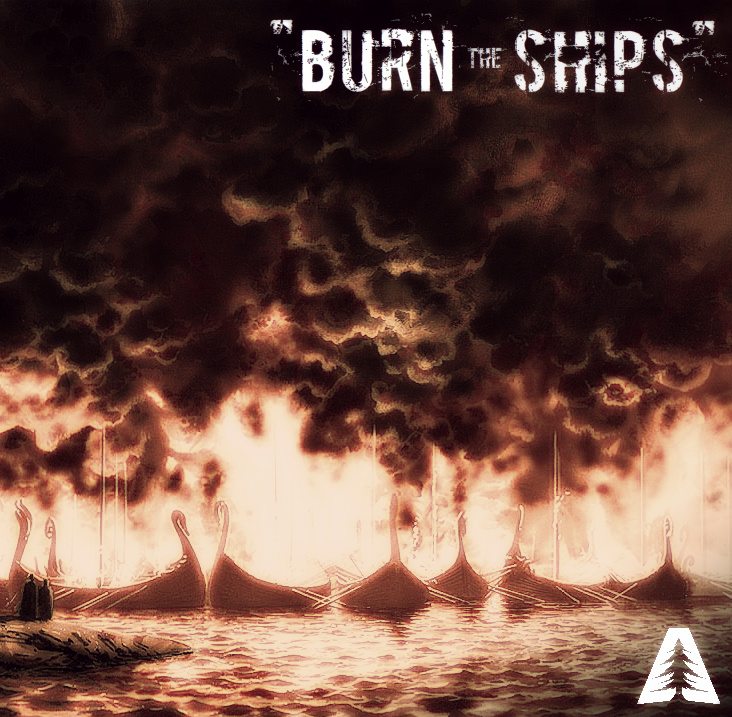Often, we are asked where the name “Burn the Ships” comes from. To us, it’s a personal mantra; a statement about the willingness to put forth everything to achieve victory.
The act of burning one’s own ships is the physical manifestation of this idea; a tactic that military commanders throughout history have used to overcome the challenges that made everyone before them simply avoid the venture. Thus, we found ourselves - both as military commanders and entrepreneurs - inspired by the words, “Burn the Ships.”
With that, I want to share with you why this statement has meaning; the many stories that have made the firing of masts, hulls and sails into a bold ideology (and incredible ale). This, ladies and gentlemen, is the story of “Burn the Ships.”
Hellespont Strait, 334 BC
At the young age of 21, Alexander has already become ruler over all of Greece and the Balkans. He now turns his eyes to the East, where the Persian Empire controls a massive kingdom stretching from the shores of the Mediterranean Sea to the peaks of the Himalayas.
The Greeks and Persians share a long, violent history, which includes the invasion of Greece by Emperor Xerxes in years past. Alexander desires to return the favor; to bring an end to the empire that has controlled much of the known world for centuries. He understands it will not be an easy feat, as the Persians currently maintain the largest ground and naval force ever seen. Although Alexander plans to invade with an army numbering over 80,000 soldiers, cavalrymen and sailors, he is outnumbered 5 to 1.
Alexander knows this, but still believes he can achieve victory.
The only geographic barrier between him and the Persian Empire is a narrow strait called the Hellespont; a waterway running the 38-mile distance from the Mediterranean to the Marmara Sea. While its length could be considered a decent voyage, the strait is a mere 3-miles across at the widest point. This narrow body of water is where Alexander plans to begin his conquest of Persia.
It takes 120 ships to move his army across the Hellespont to the eastern shore, where modern-day Turkey lies. With them, they carry only a 30-day supply of rations for a conquest that will undoubtedly take years.
Upon landing, Alexander is first to step onto the beach. He spikes his spear into the sand and takes a knee to thank the gods for this new land. Although much of his beloved country is still in sight behind him across the water, with thousands of miles filled with hundreds of thousands of enemy soldiers ahead of him, he believes victory is at hand the moment he steps ashore. By simply choosing to embark on this quest, he knows in his heart he has already won.
Alexander then issues his first order of the campaign: “Burn the Ships.”
His commanders are shocked. As legend has it, they plea with Alexander, asking him why they should set fire to the one asset that could return them home? Alexander replied, “We will go home in Persian ships.”
By removing their ability to retreat when difficult challenges were inevitably faced, Alexander knows he and his men will muster whatever it takes to conquer the mighty Persians. In the months and years that follow, he is proven correct:
Despite the Persian’s “scorched earth” strategy - where they actively destroyed farms, markets and infrastructure ahead of Macedonian army in order to starve them into surrender - Alexander successfully resources rations locally, building and maintaining a robust supply chain in his wake.
Alexander adopts innovative strategies in battle. He chooses to fight many of them on the banks of rivers, making the Persian’s primary combat asset - the chariot - ineffective. He often separates his army into smaller, more mobile units, allowing him to easily outmaneuver the larger Persian forces. He forms alliances with those who dare not oppose him, and decisively defeats those who do. The Macedonians quickly gain a reputation as an unbeatable force; always one step ahead of Persian forces. Alexander's innovative battle tactics were so successful that many of them are still taught to this day at military academies around the world.
No matter what challenges come their way, Alexander and his men find the will to continue on and overcome them. After all, they had no choice.
Two years later, at the Siege of Tyre, Alexander’s vision is realized: he acquires 80 Persian warships, along with the allegiance of their crews. He ultimately eliminates the last pockets of the Persian Empire in 328 BC. When his time comes to an end many years later, Alexander rules as King of Macedonia, King of Persia, King of Asia, and Pharaoh of Egypt. Most notably, he was undefeated in battle.
The surest way to avoid greatness is to back down amidst the challenges in pursuing it; to turn back upon the sight of a seemingly impossible obstacle. Alexander knew this. He believed nothing was impossible; that anything could be overcome with superior will. By setting fire to his ships on the eastern shore of the Hellespont, he simplified the situation for both he and his men: there was no backing down, no turning back. This is what elevates young Alexander into the man known in the history books as Alexander the Great.
With that, I will raise a fresh pint of BtS tonight to Alexander and his decision to “Burn the Ships.” I invite you to do the same. Cheers.
Read on:
Chapter 2
Chapter 3
Chapter 4
Chapter 5
Chapter 6
-Carl
Owner | Engineer | Brewer










